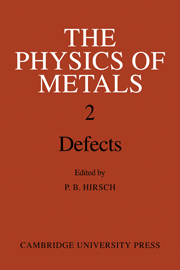Summary
By convention a Festschrift is a collection of pretty ‘essays’ by a miscellany of scholars, presented to an older and greater scholar at some significant milestone of his life. The present work conforms to this convention only in that it was conceived as a tribute to Professor Sir Nevill Mott upon the occasion of his 60th birthday.
The prime intention was to write a modern version of ‘Mott and Jones’ – a comprehensive and up-to-date account of the Theory of Metals and Alloys. But much has been discovered in 30 years, and this would have stretched to many thousands of pages. We therefore decided to concentrate on the two major topics where our interests mainly lie – the electronic structure and electrical properties of metals, on the one hand, and the mechanical properties of solids on the other. In the end, each topic grew and diverged into a separate book.
The first volume, Electrons, published in 1969, gave an account of current understanding of the electron theory of metals, with particular reference to band structure, Fermi surfaces and transport properties. The present, second, volume deals with lattice defects and the mechanical properties of metals and alloys. Although the titles of the various chapters (Point defects, Crystal dislocations, Observations of defects in metals by electron microscopy, Solution and precipitation hardening, Work hardening, and Fracture) suggest a systematic coverage of a very large field in Physics and Metallurgy, the book is certainly not intended to be a comprehensive review of the subject.
- Type
- Chapter
- Information
- The Physics of Metals , pp. v - viPublisher: Cambridge University PressPrint publication year: 1976



